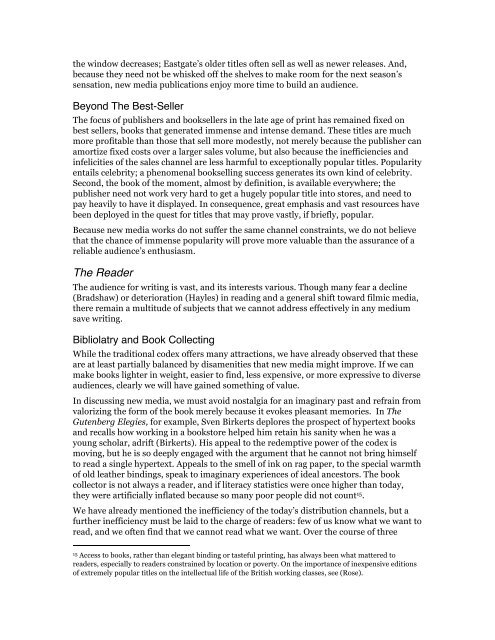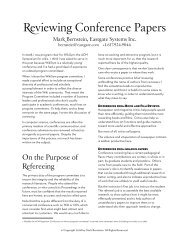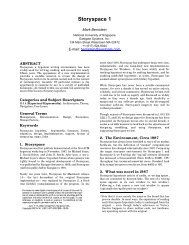Genre: Designing a New Media Economy - Mark Bernstein
Genre: Designing a New Media Economy - Mark Bernstein
Genre: Designing a New Media Economy - Mark Bernstein
Create successful ePaper yourself
Turn your PDF publications into a flip-book with our unique Google optimized e-Paper software.
the window decreases; Eastgate’s older titles often sell as well as newer releases. And,because they need not be whisked off the shelves to make room for the next season’ssensation, new media publications enjoy more time to build an audience.Beyond The Best-SellerThe focus of publishers and booksellers in the late age of print has remained fixed onbest sellers, books that generated immense and intense demand. These titles are muchmore profitable than those that sell more modestly, not merely because the publisher canamortize fixed costs over a larger sales volume, but also because the inefficiencies andinfelicities of the sales channel are less harmful to exceptionally popular titles. Popularityentails celebrity; a phenomenal bookselling success generates its own kind of celebrity.Second, the book of the moment, almost by definition, is available everywhere; thepublisher need not work very hard to get a hugely popular title into stores, and need topay heavily to have it displayed. In consequence, great emphasis and vast resources havebeen deployed in the quest for titles that may prove vastly, if briefly, popular.Because new media works do not suffer the same channel constraints, we do not believethat the chance of immense popularity will prove more valuable than the assurance of areliable audience’s enthusiasm.The ReaderThe audience for writing is vast, and its interests various. Though many fear a decline(Bradshaw) or deterioration (Hayles) in reading and a general shift toward filmic media,there remain a multitude of subjects that we cannot address effectively in any mediumsave writing.Bibliolatry and Book CollectingWhile the traditional codex offers many attractions, we have already observed that theseare at least partially balanced by disamenities that new media might improve. If we canmake books lighter in weight, easier to find, less expensive, or more expressive to diverseaudiences, clearly we will have gained something of value.In discussing new media, we must avoid nostalgia for an imaginary past and refrain fromvalorizing the form of the book merely because it evokes pleasant memories. In TheGutenberg Elegies, for example, Sven Birkerts deplores the prospect of hypertext booksand recalls how working in a bookstore helped him retain his sanity when he was ayoung scholar, adrift (Birkerts). His appeal to the redemptive power of the codex ismoving, but he is so deeply engaged with the argument that he cannot not bring himselfto read a single hypertext. Appeals to the smell of ink on rag paper, to the special warmthof old leather bindings, speak to imaginary experiences of ideal ancestors. The bookcollector is not always a reader, and if literacy statistics were once higher than today,they were artificially inflated because so many poor people did not count 15 .We have already mentioned the inefficiency of the today’s distribution channels, but afurther inefficiency must be laid to the charge of readers: few of us know what we want toread, and we often find that we cannot read what we want. Over the course of three15Access to books, rather than elegant binding or tasteful printing, has always been what mattered toreaders, especially to readers constrained by location or poverty. On the importance of inexpensive editionsof extremely popular titles on the intellectual life of the British working classes, see (Rose).




